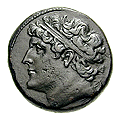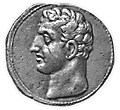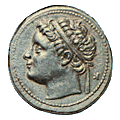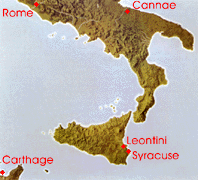| Back to . . . | This section . . . |
|
 Hiero II (306?-215 BC)  Hannibal(?) (247-183? BC)  Hieronymos (230?-214 BC)  Marcellus (268-208 BC)  Archimedes (287?-212 BC) planning the defenses of
Archimedes (287?-212 BC) planning the defenses ofSyracuse |

At the beginning of the third century BC, the Mediterranean basin was controlled by the Carthaginians in the west and the Greeks in the east. The Romans controlled only a small area around Rome, but were poised to march. They locked horns with Carthage in the First Punic War (264-241 BC), during which they greatly expanded their territory, although they did not capture the city of Carthage itself. The Greek city of Syracuse, where Archimedes lived, initially supported Carthage. But early in the war Rome forced a treaty of alliance from Syracuse's king, Hiero II, that called for Syracuse to pay tribute and provide grain to the Romans. The Romans and Carthaginians renewed their antagonisms in 218 BC, the beginning of the Second Punic War. Under Hannibal, Carthage gained the first round of victories, culminating in Hannibal's crossing of the Alps into Italy (218 BC) and his defeat of the Romans at Cannae (216 BC). Hannibal's successes in Italy helped convince many Syracusans that they were allied with the wrong side. Hiero honored his treaty with Rome while he lived. However, upon his death in 215 BC he was succeeded by his 15-year-old grandson Hieronymos who began negotiations with Hannibal. This alarmed the pro-Roman faction within Syracuse, and so in 214 BC while Hieronymos was visiting the neighboring Greek city of Leontini they had him assassinated, ending his 13-month reign. His assassination led to civil strife in Syracuse between the pro-Carthaginian and pro-Roman factions, during which most of Hiero's family was killed. The pro-Carthaginian faction was eventually victorious and two brothers of mixed Carthaginian-Syracusan descent, Hippokrates and Epikydes, took control of the city. The Romans sent Marcus Claudius Marcellus to Sicily to deal with the Syracusan situation. He first took Leontini by force and had some 2000 Carthaginian sympathizers within its walls beaten and beheaded. This typical Roman savagery following the defeat of a city squelched any desire of the Syracusans to negotiate with Marcellus. Marcellus then besieged Syracuse in 213 BC. He attacked the coastal walls of Syracuse with sixty quinqueremes (battleships with five-man oar banks) while his co-commander, Appius Claudius Pulcher, attacked the inland walls with ground troops. However, Archimedes had been King Hiero's military adviser for many years and had well prepared Syracuse for any attack. The devices he employed for the defense of Syracuse and their success against the Roman siege are described in detail by the following four writers:
The links to these writers lead to their accounts of the siege of Syracuse and Archimedes' defenses. (See also the material on Archimedes' Claw.) Polybius's account is the most trustworthy as he would have had access to survivors of that siege.
|